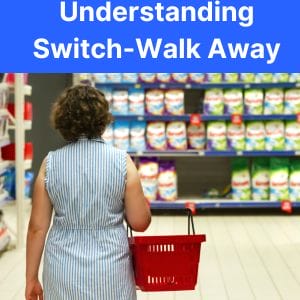
Understanding “Switch or Walk Away”: A Game-Changer for Category Management
Picture this: A shopper stands in front of a shelf, searching for their favorite item. It’s out of stock.
What happens next?
Do they grab a substitute, walk out empty-handed, or go straight to a competitor? These moments of decision matter, and understanding them can make or break a category’s performance.
At Shopper Intelligence, we tackle this scenario head-on with our Switch or Walk Away insights.
By exploring how shoppers react when their preferred product isn’t available, we uncover actionable insights into shopper loyalty, brand importance, and the potential impact of out-of-stocks on sales.
The “Switch or Walk Away”: What It Reveals
The premise is straightforward. After identifying what a shopper purchased —down to specifics like size, flavor, or brand—we ask:
- Would you have switched to another product within the category?
- Or would you have walked away, choosing not to buy at all?
This straightforward question uncovers key insights about shopper loyalty, brand stickiness, and the likelihood of lost sales. The responses vary widely by category, brand and segment, shedding light on which have loyal shoppers and which do not.
For example:
- Categories like general merchandise and household goods tend to see higher walk-away rates. Shoppers leave the store if their first-choice product isn’t available.
- Meanwhile, shoppers in categories like dairy and bakery tend to switch to a comparable product within the category.
Why “Switch or Walk Away” Matters
Understanding whether shoppers will switch or walk away has significant implications for retailers and suppliers:
1. Informs Assortment and Shelving Strategies
For categories with high walk-away rates, retailers must ensure that key products and brands are always available and easy to find. A single out-of-stock situation or poorly located product could mean lost revenue for the retailer and the entire category.
2. Prioritizes Key Brands
When shoppers demonstrate high brand loyalty, brands and retailers can prioritize these products in their assortment and promotional planning. For brands with low switching rates, an out-of-stock situation could mean the shopper leaves the store altogether.
3. Highlights Incrementality
Brands with high switching rates might add less incremental value to the category than their loyal counterparts. Retailers can use this insight to refine their mix of products, ensuring every SKU contributes to category growth.
4. Improves Shelf Visibility
The challenge isn’t always about products being out of stock. Sometimes, shoppers can’t find what they’re looking for due to poor shelf visibility. Retailers must optimize layouts and signage to ensure key products are easy to locate.
Implications for Retailers and Suppliers
For retailers, the “Switch or Walk Away” metric is a valuable lens for prioritizing inventory management, reducing out-of-stocks, and refining category strategies. Knowing where to focus resources ensures that high-value categories perform at their best.
This insight is crucial for suppliers to understand a brand’s role within the category. If a brand has high loyalty and low switching rates, it’s important to advocate for shelf space and ensure robust supply chain management to avoid stockouts. Conversely, suppliers might focus on promotions or partnerships for more replaceable brands to capture switching shoppers.
A Case in Point: Visualizing Walk-Away Behavior
The data shared shows that categories like general merchandise and household have the highest walk-away rates. Shoppers in these categories are likelier to leave the store entirely if their preferred product isn’t available, underscoring the importance of robust inventory strategies for these departments.
In contrast, shoppers in categories like dairy and bakery exhibit more flexibility, often switching to alternative products rather than walking away. Optimizing assortment breadth and ensuring adequate stock levels for a range of products can significantly improve sales retention for these categories.
Turning Insights into Action
Shopper Intelligence’s Switch or Walk Away is valuable for making informed decisions that drive category performance and shopper satisfaction. Here’s how you can leverage these insights:
- Analyze Your Categories: Understand where your category falls on the loyalty vs. flexibility spectrum.
- Collaborate Strategically: Partner with retailers to prioritize key products in high-walk-away categories.
- Optimize Assortment: Use switching behaviors to refine your product mix, focusing on high-value SKUs.
- Enhance Visibility: Invest in merchandising to make key products easy to find, minimizing lost sales due to shelf confusion.
Ready to See Your Category in Action?
The Switch or Walk Away metric is just one example of how Shopper Intelligence helps retailers and suppliers uncover the “why” behind shopper behavior.
If you’re ready to improve your category management decisions, let us show you how this metric applies to your categories.